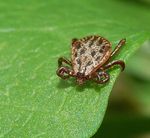Difference between revisions of "Dermacentor spp."
| (7 intermediate revisions by 2 users not shown) | |||
| Line 1: | Line 1: | ||
| − | {{ | + | {{OpenPagesTop}} |
{{Taxobox | {{Taxobox | ||
|name =''Dermacentor spp.'' | |name =''Dermacentor spp.'' | ||
|kingdom =Animalia | |kingdom =Animalia | ||
|sub-kingdom = | |sub-kingdom = | ||
| − | |phylum =Arthropoda | + | |phylum =[[:Category:Arthropods|Arthropoda]] |
|super-class = | |super-class = | ||
| − | |class =Arachnida | + | |class =[[:Category:Arachnida|Arachnida]] |
|sub-class =Acari | |sub-class =Acari | ||
|super-order =Parasitiformes | |super-order =Parasitiformes | ||
| Line 17: | Line 17: | ||
|species =Many | |species =Many | ||
}} | }} | ||
| − | + | ==Introduction== | |
[[File:Dermacentor reticulatus.jpg|150px|thumb|right|''D.reticulatus'' male - Rainer Altenkamp 2007, Wikimedia Commons ]] | [[File:Dermacentor reticulatus.jpg|150px|thumb|right|''D.reticulatus'' male - Rainer Altenkamp 2007, Wikimedia Commons ]] | ||
| − | ''Dermacentor spp.'' can be identified by; | + | ''Dermacentor spp.'' of ticks can be identified by; |
*Wide palps | *Wide palps | ||
*Rectangular base of capitulum | *Rectangular base of capitulum | ||
| Line 27: | Line 27: | ||
*Festoons on the posterior margin | *Festoons on the posterior margin | ||
| − | There are two species found in the UK and Europe ''D.reticulatus'' and ''D.marginatus'', the ornate sheep tick however this is absent from the UK. ''D.reticulatus'' is a three host tick found on meadows, pastures and forests in England and Wales. Adults will parasitise large mammals whilst larval and nymphal stages attack small mammals, insectivores and sometimes birds. The tick is known to transmit a number of disease in man and and veterinary species. ''D.reticulatus'' is responsible for transmitting ''[[Babesia]] canis'' in dogs, ''B.divergens'' and ''B.ovis''in cattle as well as Q fever (''[[Coxiella burnetti|C.burnetti]]''), tularemia, ''[[Brucella species|Brucella]]'', ''Anaplasma ovis'' and ''Rickettsia conorii'' the cause of Boutonneuse fever. In horse ''D.reticulatus'' is responsible for the transmission of ''Babesia caballi'' and ''B.equi''. | + | There are two species found in the UK and Europe ''D.reticulatus'' and ''D.marginatus'', the ornate sheep tick however this is absent from the UK. ''D.reticulatus'' is a three host tick found on meadows, pastures and forests in England and Wales. Adults will parasitise large mammals whilst larval and nymphal stages attack small mammals, insectivores and sometimes birds. The tick is known to transmit a number of disease in man and and veterinary species. ''D.reticulatus'' is responsible for transmitting ''[[Babesia]] canis'' in dogs, ''B.divergens'' and ''B.ovis''in cattle as well as Q fever (''[[Coxiella burnetti|C.burnetti]]''), tularemia, ''[[Brucella species|Brucella]]'', ''[[Anaplasma ovis]]'' and ''Rickettsia conorii'' the cause of Boutonneuse fever. In horse ''D.reticulatus'' is responsible for the transmission of ''Babesia caballi'' and ''B.equi''. |
| − | [ | + | |
| + | |||
| + | {{Learning | ||
| + | |literature search = [http://www.cabdirect.org/search.html?rowId=1&options1=AND&q1=Dermacentor&occuring1=title&rowId=2&options2=AND&q2=&occuring2=freetext&rowId=3&options3=AND&q3=&occuring3=freetext&publishedstart=2000&publishedend=yyyy&calendarInput=yyyy-mm-dd&la=any&it=any&show=all&x=47&y=10 ''Dermacentor'' publications since 2000] | ||
| + | |Vetstream = [https://www.vetstream.com/canis/search?s=tick Tick] | ||
| + | }} | ||
| + | |||
| + | |||
| + | {{review}} | ||
| + | |||
| + | {{OpenPages}} | ||
| + | |||
| + | [[Category:Hard_Ticks_-_UK]][[Category:Expert_Review]] | ||
Latest revision as of 17:21, 4 June 2016
| Dermacentor spp. | |
|---|---|
| Kingdom | Animalia |
| Phylum | Arthropoda |
| Class | Arachnida |
| Sub-class | Acari |
| Super-order | Parasitiformes |
| Order | Ixodida |
| Super-family | Ixodidea |
| Family | Ixodidae |
| Genus | Dermacentor |
| Species | Many |
Introduction
Dermacentor spp. of ticks can be identified by;
- Wide palps
- Rectangular base of capitulum
- Eyes
- Ornate
- Posterior anal groove
- Festoons on the posterior margin
There are two species found in the UK and Europe D.reticulatus and D.marginatus, the ornate sheep tick however this is absent from the UK. D.reticulatus is a three host tick found on meadows, pastures and forests in England and Wales. Adults will parasitise large mammals whilst larval and nymphal stages attack small mammals, insectivores and sometimes birds. The tick is known to transmit a number of disease in man and and veterinary species. D.reticulatus is responsible for transmitting Babesia canis in dogs, B.divergens and B.ovisin cattle as well as Q fever (C.burnetti), tularemia, Brucella, Anaplasma ovis and Rickettsia conorii the cause of Boutonneuse fever. In horse D.reticulatus is responsible for the transmission of Babesia caballi and B.equi.
| Dermacentor spp. Learning Resources | |
|---|---|
To reach the Vetstream content, please select |
Canis, Felis, Lapis or Equis |
 Search for recent publications via CAB Abstract (CABI log in required) |
Dermacentor publications since 2000 |
| This article has been peer reviewed but is awaiting expert review. If you would like to help with this, please see more information about expert reviewing. |
Error in widget FBRecommend: unable to write file /var/www/wikivet.net/extensions/Widgets/compiled_templates/wrt664a90019c2f39_33787682 Error in widget google+: unable to write file /var/www/wikivet.net/extensions/Widgets/compiled_templates/wrt664a9001a06cb5_82447228 Error in widget TwitterTweet: unable to write file /var/www/wikivet.net/extensions/Widgets/compiled_templates/wrt664a9001a40608_54271777
|
| WikiVet® Introduction - Help WikiVet - Report a Problem |
